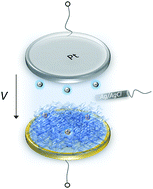当前位置:
X-MOL 学术
›
J. Mater. Chem. C
›
论文详情
Our official English website, www.x-mol.net, welcomes your feedback! (Note: you will need to create a separate account there.)
Ionic-to-electronic coupling efficiency in PEDOT:PSS films operated in aqueous electrolytes†
Journal of Materials Chemistry C ( IF 6.4 ) Pub Date : 2018-07-11 00:00:00 , DOI: 10.1039/c8tc02195c Achilleas Savva 1, 2 , Shofarul Wustoni 1, 2 , Sahika Inal 1, 2
Journal of Materials Chemistry C ( IF 6.4 ) Pub Date : 2018-07-11 00:00:00 , DOI: 10.1039/c8tc02195c Achilleas Savva 1, 2 , Shofarul Wustoni 1, 2 , Sahika Inal 1, 2
Affiliation

|
Poly(3,4-ethylenedioxythiophene):poly(styrenesulfonate), PEDOT:PSS, is a polymeric mixed conductor used in the vast majority of devices in bioelectronics, electrochromics, energy storage/generation, neuromorphic computing, and thermoelectrics. These devices operate at the interface with electrolytes and rely on the uptake of mobile ions by the film, making the coupling between electronic and ionic charges crucial. For efficient transduction of ionic charges into electronic ones, all the ions injected into the film should lead to a change in conductivity. Although extensively studied, fundamental knowledge regarding the losses during this process is lacking. In this study, we quantify the efficiency of ion-to-electron coupling in PEDOT:PSS films by measuring the number of cations taken up by the film as well as the in situ current generated as a result of their interactions with the electrically active sites. We find that not all the injected cations are used for reducing PEDOT oligomers in thick films and some of these ions remain in the film upon de-doping. The efficiency of ion-to-electron transduction thus varies with thickness, a parameter which critically affects the distribution of PEDOT and PSS in the bulk as revealed by Raman spectroscopy, X-ray photoelectron spectroscopy and scanning transmission electron microscopy studies. Tracking the traces of ions, we provide guidelines on how to maximize the coupling between ionic and electronic charges for high performance transducers. Our approach is thus fundamental to future development and optimization of mixed conductors applied at the interface with electrolytes.
中文翻译:

在水性电解质中运行的PEDOT:PSS膜中的离子与电子的耦合效率†
聚(3,4-乙撑二氧噻吩):聚(苯乙烯磺酸盐),PEDOT:PSS是一种聚合物混合导体,广泛用于生物电子,电致变色,能量存储/生成,神经形态计算和热电学中的大多数设备。这些设备在与电解质的界面处工作,并依赖于薄膜对移动离子的吸收,从而使电子和离子电荷之间的耦合变得至关重要。为了将离子电荷有效地转换为电子电荷,注入到薄膜中的所有离子都应导致电导率的变化。尽管进行了广泛研究,但缺乏有关此过程中的损失的基本知识。在这项研究中,我们通过测量薄膜吸收的阳离子数量以及原位的数量来量化PEDOT:PSS薄膜中离子与电子的耦合效率由于它们与电活性位点相互作用而产生的电流。我们发现并非所有注入的阳离子都用于还原厚膜中的PEDOT低聚物,并且其中一些离子在去掺杂后仍保留在膜中。因此,离子到电子的转换效率随厚度而变化,该参数严重影响PEDOT和PSS在整体中的分布,如拉曼光谱,X射线光电子能谱和扫描透射电子显微镜研究所揭示的那样。跟踪离子的痕迹,我们提供了有关如何使高性能换能器的离子电荷与电子电荷之间的耦合最大化的指南。因此,我们的方法是将来开发和优化与电解质界面处使用的混合导体的基础。
更新日期:2018-07-11
中文翻译:

在水性电解质中运行的PEDOT:PSS膜中的离子与电子的耦合效率†
聚(3,4-乙撑二氧噻吩):聚(苯乙烯磺酸盐),PEDOT:PSS是一种聚合物混合导体,广泛用于生物电子,电致变色,能量存储/生成,神经形态计算和热电学中的大多数设备。这些设备在与电解质的界面处工作,并依赖于薄膜对移动离子的吸收,从而使电子和离子电荷之间的耦合变得至关重要。为了将离子电荷有效地转换为电子电荷,注入到薄膜中的所有离子都应导致电导率的变化。尽管进行了广泛研究,但缺乏有关此过程中的损失的基本知识。在这项研究中,我们通过测量薄膜吸收的阳离子数量以及原位的数量来量化PEDOT:PSS薄膜中离子与电子的耦合效率由于它们与电活性位点相互作用而产生的电流。我们发现并非所有注入的阳离子都用于还原厚膜中的PEDOT低聚物,并且其中一些离子在去掺杂后仍保留在膜中。因此,离子到电子的转换效率随厚度而变化,该参数严重影响PEDOT和PSS在整体中的分布,如拉曼光谱,X射线光电子能谱和扫描透射电子显微镜研究所揭示的那样。跟踪离子的痕迹,我们提供了有关如何使高性能换能器的离子电荷与电子电荷之间的耦合最大化的指南。因此,我们的方法是将来开发和优化与电解质界面处使用的混合导体的基础。


























 京公网安备 11010802027423号
京公网安备 11010802027423号